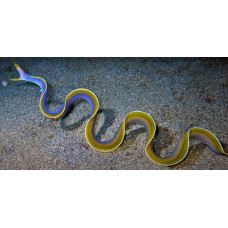Latin name
Rhinomuraena quaesita
Other names
Leaf-nosed moray eel, bernis eel, ribbon moray, leafnosed moray eel, blue ribbon moray, blue ribbon eel, black ribbon moray, black ribbon eel, black leafnosed moray eel, bernis eel.
Identification
The body is slender, ribboned, the head small with an elongated pointed muzzle. There is a small conical fleshy projection at the tip of the nose and the nostrils are turned into bright, broad, leaf-like lobes. The lower jaw has three thin, soft projections (tentacles). The ribbon eel is known for its distinctive jaws, which often open wide when a diver approaches. The spine has 270-286 vertebrae. The long, narrow body has no scales but is covered in a thick protective mucus that allows it to slip into the most inaccessible places. Another amazing feature of their appearance is their olfactory organs, which are shaped like delicate leaves. These extra nostrils are their main tool for finding small fish in the rocky crevices of coral reefs.
Features of fish fins
Dorsal processes (total): 0. Anal ramifications: 0.
Fish colouring
At the beginning of their development the fish are mostly black as tar with a yellow dorsal fin. In adult males the black colouration is replaced by a bright blue-yellow. The adult female is completely yellow or yellow with a small amount of blue on the back. Colour changes associated with sex change are not known in any other moray eel species. It is thought that even if there are significant colour changes during development, colour does not play a significant role in mating because eels are colour-blind (possessing only one of the two photoreceptor cells needed to perceive colour). In captivity, differences in colouration are not related to maturity or sex.
Distribution
Ribbon eels are found in tropical areas of the Indian and Pacific Oceans, from East Africa to southern Japan, Australia and French Polynesia.
Habitat
Occupies sandy burrows and reefs in the Indo-Pacific. Prefers shallower waters than other morays, often burrowing at depths of 1 to 57 metres.
Size
Adult blue males range from 65 to 94 centimetres (26 to 37 inches) in length, while larger yellow females can reach 130 centimetres (51 inches).
Behavior
Does not migrate. Diurnal (active during daylight hours). The head and front of the body often protrude from crevices in sandy and rubbly habitats such as coral reefs, through which they can slip using their mucous membranes.
Food and feeding habits
They hunt from ambush and do not stalk their prey. Diet consists mainly of fish, shrimp and squid.
Reproduction
The ribbon eel larva is described as a large greenish leptocephalus. Based on the observed colour changes, the ribbon eel is generally considered to be a protandrous hermaphrodite (male to female transformation). When necessary, males develop reproductive organs, lay eggs and then die. This stage of development takes about a month. In their natural habitat, banded eels can live up to twenty years.
Fishing
It is fished for the aquarium industry.
Relationship with a person
Most ribbon eels do not live more than a year in captivity. In many cases it has been observed that the fish stop eating after being caught and placed in home aquariums. A higher success rate has been achieved in public aquariums where several spawning events have been recorded under European and North American conditions.
| Classification | |
| Phylum | Chordata |
| Class | Actinopterygii |
| Squad | Anguilliformes |
| Family | Muraenidae |
| Genus | Rhinomuraena |
| Species | R. quaesita |
| Features | |
| Conservation status | Least Concern |
| Habitat | Bottom |
| Life span, years | 20 |
| Maximum body weight, kg | No information |
| Maximum length, cm | 130 |
| Sailing speed, m/s | No information |
| Threat to people | Not edible |
| Way of eating | Predator |
Ribbon eel
Tags: ribbon eel




